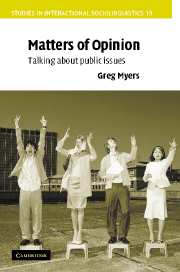Book contents
- Frontmatter
- Contents
- Acknowledgments
- Transcription conventions
- Focus-group data
- 1 Paradoxes of opinion
- 2 A tool kit for analysing group discussions
- 3 Forums for opinion: ‘What is it that's going on here?’
- 4 Institutions of opinion: voice of the people?
- 5 Topics in interaction: ‘Why that now?’
- 6 Agreeing and disagreeing: maintaining sociable argument
- 7 Representing speech: other voices, other places
- 8 Questioning expertise: Who says?
- 9 Radio phone-ins: mediated sociable argument
- 10 Vox pop television interviews: constructing the public
- 11 Opinions as talk
- References
- Index
7 - Representing speech: other voices, other places
Published online by Cambridge University Press: 22 September 2009
- Frontmatter
- Contents
- Acknowledgments
- Transcription conventions
- Focus-group data
- 1 Paradoxes of opinion
- 2 A tool kit for analysing group discussions
- 3 Forums for opinion: ‘What is it that's going on here?’
- 4 Institutions of opinion: voice of the people?
- 5 Topics in interaction: ‘Why that now?’
- 6 Agreeing and disagreeing: maintaining sociable argument
- 7 Representing speech: other voices, other places
- 8 Questioning expertise: Who says?
- 9 Radio phone-ins: mediated sociable argument
- 10 Vox pop television interviews: constructing the public
- 11 Opinions as talk
- References
- Index
Summary
Institutions of opinion promise to deliver ‘the voices of the people’ (Gallup and Rae 1940), letting the young parent, the unemployed plasterer, the company director, the retired nurse speak for themselves. Now imagine a poll in which respondents could, at any moment, answer for someone else, so the company director says what a young single mother might say on this issue, or the nurse speaks for a poor person in another country. All the careful sampling and standardization would go out the window. And yet, as we saw in Chapter 6, participants in interviews and focus groups can and do speak for others, attributing opinions to other people, telling stories, enacting voices. Analysts and readers may pay little attention to these shifts, just because they are so much a part of everyday talk. But they are crucial to understanding what opinions are doing. Participants can use other voices, not to evade giving their own opinion, but to make an opinion rhetorically effective, in all its complexities, relations, and ambivalences. In Frame Analysis, Erving Goffman notes our attachment to ‘the basic notion that in daily life the individual ordinarily speaks for himself, speaks, as it were, in his “own” character. However, when one examines speech, especially the informal variety, this traditional view proves inadequate’ (1974: 512). Goffman shows that there are many ways of shifting to another character: a change of clothes (taking off a tie), a movement (posing like a fashion model), a position (taking a seat at a meeting).
- Type
- Chapter
- Information
- Matters of OpinionTalking About Public Issues, pp. 134 - 156Publisher: Cambridge University PressPrint publication year: 2004



